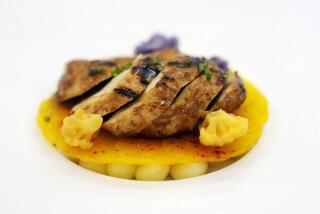Food lovers await the Italian ‘king of salumi,’ thanks to USDA
- Share via
The USDA decision late last week to allow imports of more Italian cured meats already has food lovers salivating. Ask them for particulars and they will reply almost in unison: “Culatello.”
“I’m looking forward to everything, but the main one would be culatello,” says Marco Guidi, whose family has run the Italian specialty food distributor Guidi Marcello in Santa Monica for more than 30 years.
Almost unknown in this country, culatello is the “heart” of a prosciutto ham, removed and cured separately. It has a silky texture and profound pork flavor. So great is its renown, in Italy it is known as the king of salumi.
Photos: 10 big, bold, juicy red wine choices
“Of course, it’s got to be culatello,” says Celestino Drago, owner of four Italian restaurants in Southern California.
The USDA decision, quietly published Friday in the Federal Register, cleared six Italian provinces for export of pork products to the United States. The provinces – Lombardy, Emilia-Romagna, Venice, Piedmont, Trento and Bolzano – also happen to be some of the most salumi-happy areas in all of Italy.
The decision was based on a finding that those areas were now free of swine vesicular disease, a malady first detected in the mid-1960s that can survive cooking and even long curing. It is still found in parts of central and southern Italy, but the north has been clear. So now any pork product – including fresh meat – that has been processed in a USDA-approved facility, can be brought into this country.
Almost as anticipated as culatello is something most Americans think of as lunch meat – salami. But salami in Italy is very different than the packaged stuff you buy here. There are hundreds, if not thousands, of types, each slightly different.
When Vincenti owner Maureen Vincenti asks her chef Nicola Mastronardi about what he was most excited about, he pulled down his edition of the Italian cooking encyclopedia “Grande Enciclopedia Illustrata della Gastronomia” and opened it straight to salami. “He’s pointing at every single one of them,” she said, laughing.
Gino Angelini, the chef at Angelini Osteria and RivaBella was born in Emilia-Romagna and for him, there’s a specific salami he’s looking forward to – the one from Felino, near his hometown. “We would get only one a year for Easter,” he says. “In the morning, we’d have our colomba (Easter bread), salami di Felino and hard-cooked eggs. It was the best part of Easter.”
“I’m definitely looking forward to culatello,” says Piero Selvaggio, owner of Valentino restaurant and one of the pioneers of Italian cooking in the U.S. “But you also have to think of all of the different salame, there are so many that are so amazing.
“Now we can put together a really great salumi plate with a lot of assortment and excitement. Until now so many of these we couldn’t get unless we made them ourselves. And yes it’s nice to say they are house-made, but there is no comparison. Great stuff is great stuff.”
One of the leaders in the burgeoning house-made salumi movement in Los Angeles is Chad Colby, chef at Chi Spacca, the meat-centric sub-restaurant of Mozza. He has traveled extensively in Italy and tried to replicate many of the cured sausages he found there. And he welcomes the arrival of the real things.
“It’s really exciting, in fact, it sounds too good to be true,” he says. “Hopefully this will open up some doors of inspiration when I try to create new products. You can take pictures and make notes, but there’s nothing like having the real thing there so you can compare.”
It’s not too early to start making your own salumi wish list. What are you looking forward to?
ALSO:
Michael Cimarusti’s “seafood shack” taking shape
Jonathan Gold’s 101 Best Restaurants starts with a bang
More to Read
Eat your way across L.A.
Get our weekly Tasting Notes newsletter for reviews, news and more.
You may occasionally receive promotional content from the Los Angeles Times.











